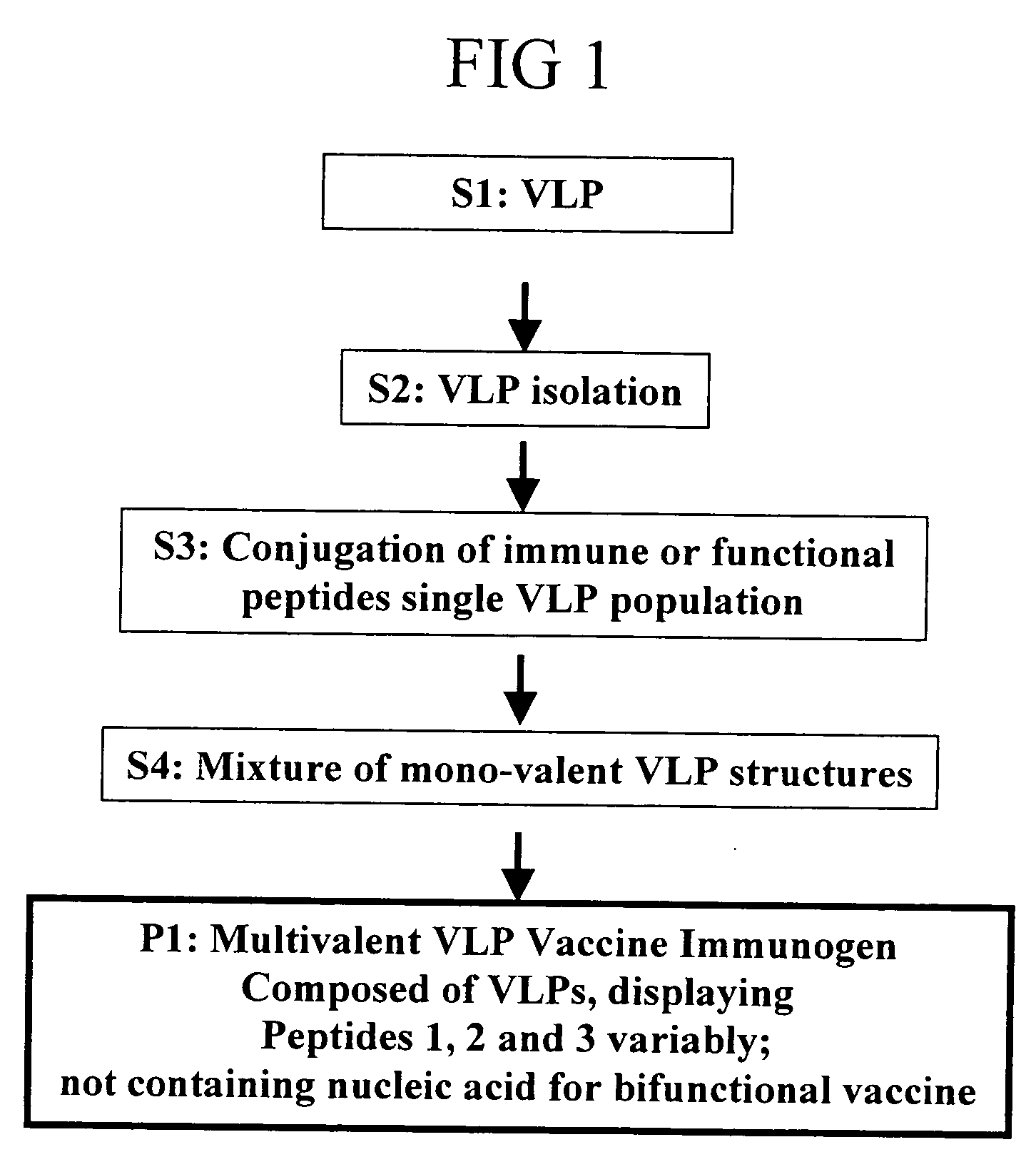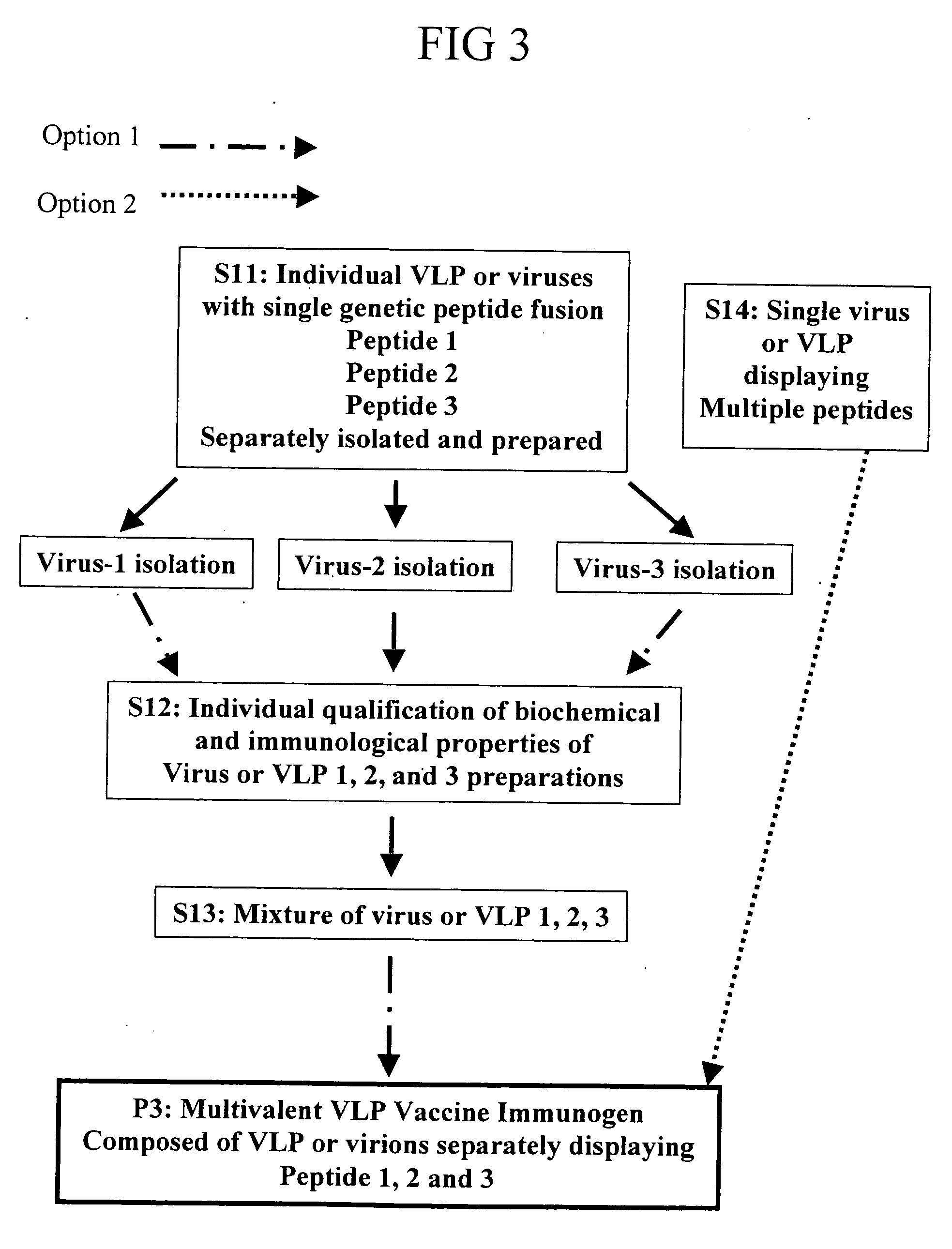Flexible vaccine assembly and vaccine delivery platform
a flexible, vaccine technology, applied in the direction of antibody medical ingredients, viruses/bacteriophages, dsdna viruses, etc., can solve the problems of severe limitations on the application of rna vaccines for mass immunization, inconvenient production, inconvenient use, etc., to facilitate efficient immune cell recognition or processing, modulate the host immune response, and strong, lasting immunological responses
- Summary
- Abstract
- Description
- Claims
- Application Information
AI Technical Summary
Benefits of technology
Problems solved by technology
Method used
Image
Examples
example 1
Peptide Fusions and Solubility as a Function of pH
[0160] The current industry standard for success with peptide fusions is 40-50%. To improve on this a series of fusions were tested at multiple insertion locations on the TMV U1 coat protein and each fusion was extracted under multiple conditions, to determine the influence of fusion position on virus solubility. This example describes the influence of genetic fusion position on the isolation of recombinant TMV viruses (step S15, FIG. 4).
[0161]FIG. 7 illustrates results for the fusion HA, inserted at four different locations on the U1 coat protein; the N terminal, C terminal, surface loop (L) and 4 amino acids from the C terminus (GPAT). Clear differences in the extent of cleavage and virus solubility were evident. Approximately 100% HA GPAT was cleaved back to wild type U1 protein molecular weight when extracted at pH 5. Re-extraction at pH 7 improved full-length yield to 50%. Tissue extraction in SDS PAGE buffer yielded full-leng...
example 2
Improving Solubility and Accumulation by Modifying the Linker Amino Acids
[0164] Molecular fusion of epitopes to TMV fail to accumulate when aromatic (for example W) or hydrophobic amino acids are present in the peptide. For example, p15e, a mouse melanoma antigen, contains the aromatic amino acid tryptophan (W). This peptide, when introduced onto the N or C-terminal positions on U1 coat, caused virus instability and no TMV systemic infection was observed. Applicant reasoned that to create a more favorable environment for peptide solubility, flanking amino acids could be added to increase hydrophilic interactions, counteracting the negative effects on virus assembly or stability when amino acids like W are introduced onto the solvent exposed surface of coat protein. Aspartic Acid (D) and Glutamic Acid (E) are amino acids that are charged, and were used to show that such a method will rescue the insoluble fusion of p15e to TMV coat (FIG. 8). Before addition of DE adjacent to the p15e...
example 3
Chemically Conjugated Epitope Fusions to TMV U1
[0165] Only a percentage (70-80%; see Example 1) of genetic fusions are capable of functional VLP formation for many plant viruses. Many fusions fail to accumulate while others are simply insoluble. The present invention includes construction of coat protein fusions containing cysteine (Cys) residues as either N-terminal or surface loop fusions. The initial fusions to TMV U1, and to other tobamovirus coat proteins showing good expression in the U1 vector, are composed of glycine-cysteine-glycine (GCG) or GGCGG as N- and surface loop fusions (FIG. 9A (1)). Previous LSBC experiences have indicated that cysteine residues are tolerated on the virion surface and that under the reducing conditions of the plant cytosol, no disulfide bridges are formed between coat protein subunits or host proteins. The production of coat protein with surface exposed Cys residues allows peptide conjugation to the TMV virions through conjugation using heterobif...
PUM
| Property | Measurement | Unit |
|---|---|---|
| Electrical conductance | aaaaa | aaaaa |
| Mass | aaaaa | aaaaa |
| Mass | aaaaa | aaaaa |
Abstract
Description
Claims
Application Information
 Login to View More
Login to View More - R&D
- Intellectual Property
- Life Sciences
- Materials
- Tech Scout
- Unparalleled Data Quality
- Higher Quality Content
- 60% Fewer Hallucinations
Browse by: Latest US Patents, China's latest patents, Technical Efficacy Thesaurus, Application Domain, Technology Topic, Popular Technical Reports.
© 2025 PatSnap. All rights reserved.Legal|Privacy policy|Modern Slavery Act Transparency Statement|Sitemap|About US| Contact US: help@patsnap.com



